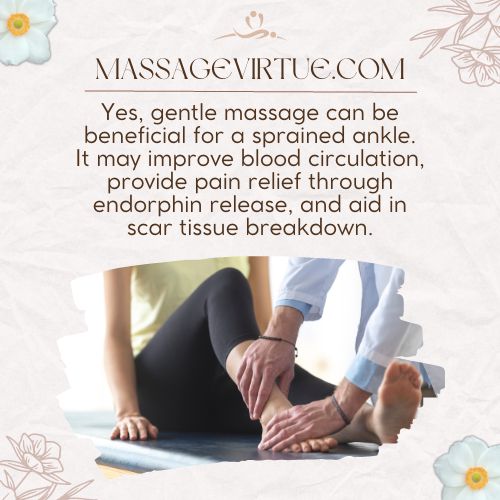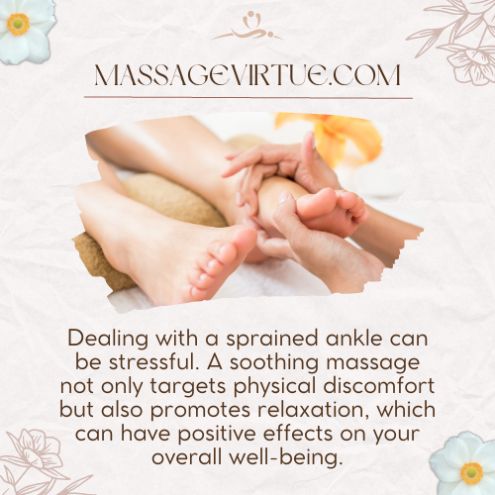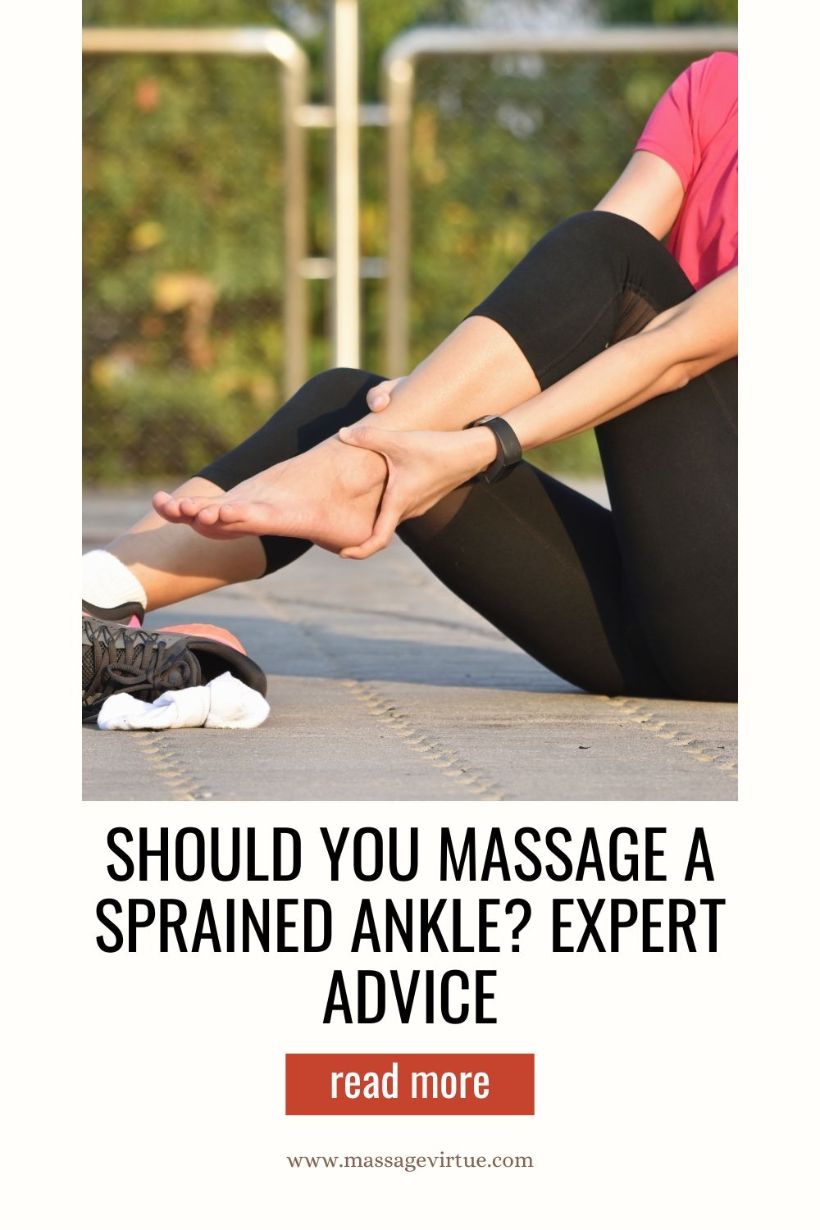So, you’ve sprained your ankle, and you’re probably dealing with discomfort, pain, and swelling.
While traditional methods like rest, ice, compression, and elevation (RICE) are commonly recommended for ankle sprains.
You might be wondering whether massage therapy could offer some relief.
In this article, we’ll delve into the question: “Should you massage a sprained ankle?” We’ll explore the benefits, precautions, and techniques of using massage therapy to aid in the recovery process.
Should You Massage Your Sprained Ankle?
Yes, gentle massage can be beneficial for a sprained ankle.

It may improve blood circulation, provide pain relief through endorphin release, and aid in scar tissue breakdown. However, caution is vital – improper massage can worsen the injury.
Always prioritize conventional treatments and medical advice in the recovery process.
The Role of Massage in Ankle Sprain Recovery
Massage therapy has gained popularity as a complementary approach to traditional treatments. When it comes to ankle sprains, gentle and controlled massage can potentially provide several benefits during the healing process:
1. Improved Blood Circulation
Massaging the affected area can stimulate blood flow, promoting the delivery of oxygen and nutrients to the injured tissues.
This increased circulation may aid in reducing swelling and promoting faster healing.
2. Pain Relief
Properly administered massage can trigger the release of endorphins, which are natural pain relievers produced by the body.
This could lead to temporary pain reduction, helping you manage discomfort more effectively.
3. Scar Tissue Management
As your body heals, it may develop scar tissue around the injured ligaments.
Massage therapy can help break down this scar tissue, improving the flexibility and range of motion of the ankle as it heals.
4. Relaxation
Dealing with a sprained ankle can be stressful. A soothing massage not only targets physical discomfort but also promotes relaxation, which can have positive effects on your overall well-being.

How to Massage a Sprained Ankle?
Massaging a sprained ankle can help you, but it’s important to do it right. Here’s a simple way to do it effectively:
1. Prepare the Area: Find a comfortable and quiet space where you can sit or lie down. Make sure the injured ankle is exposed and easily accessible.
2. Warm-Up: Gently warm up the ankle by placing your hands around it without applying pressure. This helps relax the muscles and prepares them for massage.
3. Effleurage: Begin with effleurage, which involves light strokes using your fingertips. Start from the toes and stroke upwards towards the calf. Maintain a gentle pressure to encourage blood flow.
4. Petrissage: Use your thumb and fingers to perform petrissage – kneading the muscles around the ankle in a circular motion. Be cautious not to press too hard, as the goal is to stimulate the tissues, not cause discomfort.
5. Circulatory Massage: Perform long, gliding strokes along the ankle. Start from the toes and work your way up towards the calf. This technique helps enhance blood circulation, aiding in reducing swelling and promoting healing.
6. Lymphatic Drainage: Apply light pressure with your fingers in a pumping motion. Start from the area just above the ankle and move upwards, encouraging lymphatic fluid movement to reduce swelling.
7. Scar Tissue Management: If the sprain is healing and scar tissue has formed, use gentle circular motions with your fingertips to target the scar tissue. This can help break it down and improve flexibility.
8. Be Gentle: Remember, the key is to be gentle. Avoid pressing too hard, especially on swollen areas. If you feel any pain or discomfort, stop immediately.
9. Duration: A gentle massage session can last around 5-10 minutes, initially. You can gradually increase the duration as your ankle heals and becomes more accustomed to the massage.
10. Consult a Professional: If you’re unsure about the technique or the severity of the sprain, consult a healthcare professional or a trained massage therapist before attempting self-massage.
11. Hydrate: After the massage, drink water to stay hydrated, as massage can stimulate circulation and fluid movement in the body.
Pros and Cons of Massage for Ankle Sprains
| Pros | Cons |
| Pain relief via endorphin release | Aggressive massage can worsen the injury |
| Improved circulation reducing swelling | Direct pressure may increase discomfort |
| Scar tissue breakdown enhances flexibility | Not a substitute for medical advice or treatments |
| Relaxation contributes to well-being | Severe sprains require consulting healthcare professionals first |
Conclusion
In the journey to recovery from an ankle sprain, massage therapy can serve as a valuable tool to complement conventional treatments.
Its potential benefits in managing pain, reducing scar tissue, and promoting relaxation make it a tempting option for those seeking holistic relief.
However, caution and prudence are key.
Always consult your healthcare provider before incorporating massage therapy, especially if your sprain is severe.
FAQs
Is Massaging a Sprained Ankle Good?
Yes, gently massaging a sprained ankle can be beneficial. It may help improve blood circulation, reduce pain, and promote healing.
However, it’s important to do it carefully and avoid putting too much pressure on the injured area.
Is It OK to Massage a Sprained Foot?
Yes, it’s generally okay to massage a sprained foot, but you need to be cautious. Gentle massage can promote blood flow and comfort, but avoid aggressive or painful techniques.
If in doubt, it’s a good idea to consult with a healthcare professional before attempting self-massage.
What Helps a Sprained Ankle Heal Faster?
To speed up your healing for a sprained ankle:
- Rest the ankle and avoid putting weight on it.
- Apply ice to reduce swelling.
- Compress the area with a bandage.
- Elevate the foot to reduce swelling.
- Follow medical advice, possibly using crutches.
- Gentle ankle exercises can aid recovery.
How Do You Self-Massage a Sprained Ankle?
When self-massaging a sprained ankle, go gently. Start with light touches to warm up the area.
Use soft strokes from the toes to the calf, then gently knead around the ankle.
Stroke with care to boost blood flow and use light pressure to encourage fluid movement for swelling. Remember to be gentle and consult a pro if uncertain.
What Not to Do with a Sprained Ankle?
Avoid these actions with a sprained ankle:
- Don’t put weight on the injured ankle.
- Avoid excessive movement that causes pain.
- Don’t apply heat in the initial stages.
- Avoid massaging aggressively or using excessive pressure.
- Skip high-impact activities that strain the ankle.
- Don’t ignore medical advice – seek professional help if needed.


